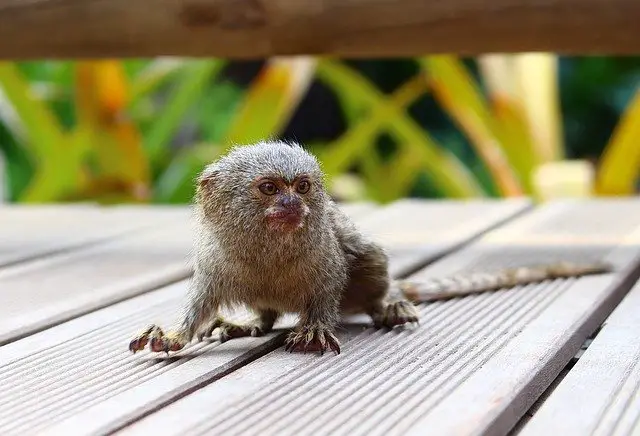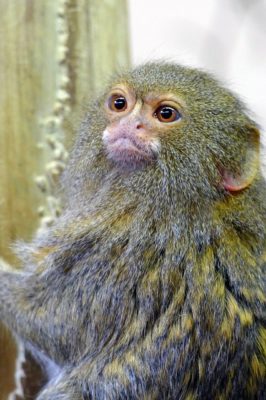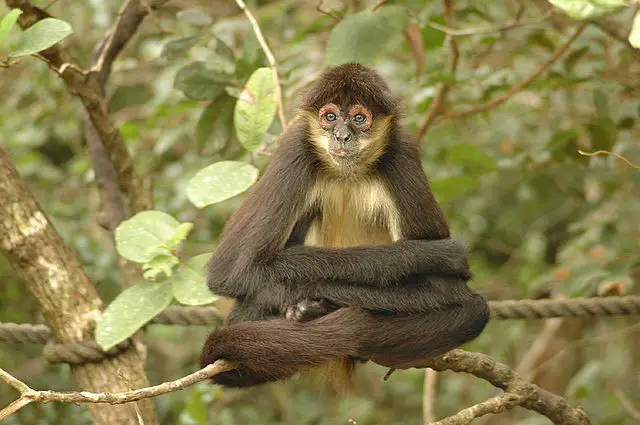Kids are always curious about the smallest and the largest animals in the world. When it comes to monkeys, Pygmy Marmoset also well known as Finger Monkey is the smallest monkey in the world. Its small size makes it look very cute among all the monkeys. We have gathered complete Finger Monkey Facts (Pygmy Marmoset Facts) that will help you in learning all about this cute monkey. You are going to learn about its appearance, size, weight, diet, habitat, lifecycle, its babies, habits, adaptations, and many Pygmy Marmoset Interesting Facts.
Finger Monkey Facts- Pygmy Marmoset Facts
1. What Is A Pygmy Marmoset – What Is A Finger Monkey
- The pygmy marmoset, which is also called finger monkey and sometimes a pocket monkey, is one of the world’s smallest primates.
- In all the New World monkeys, the pygmy marmoset or finger monkey is the smallest species with only about 100 grams body weight.
- It is indigenous to South America where it is found in the rainforests of the western Amazon Basin.
- The pygmy marmoset is gumivore (eat gums of the woody plants) and is usually found in the evergreen riparian forests adjacent to the river.

2. What Does A Finger Monkey Look Like
- A pygmy marmoset or finger monkey is a tiny true monkey that could fit easily in the hand of an adult human.
- They have a mixed color of fur with a black, grey, and brownish-golden on the head and back while the underparts have orange, yellow, yellowish-brown, and orange-brown colors.
- They have white patches on the face and a white line perpendicular to both eyes.
- They have a long tail, usually longer than the length of their entire body and head, that has rings of black color.
3. Pygmy Marmoset Classification – Pygmy Marmoset Taxonomy
| Kingdom | Animalia |
| Phylum | Chordata |
| Subphylum | Vertebrata |
| Class | Mammalia |
| Order | Primates |
| Suborder | Haplorhini |
| Infraorder | Semiliforms |
| Family | Callitrichidae |
| Genus | Cebulla |
| Species |
|
4. Finger Monkey Family
- Pygmy marmoset belongs to the Callitrichidae family that is composed of New World monkeys like tamarins, lion tamarins, and marmosets.
- All the members of this family are arboreal (adapted for the locomotion in trees) and the smallest of the monkeys, who depend on the tree gums as a major part of their diet.
- All the species of this family live in territorial groups, the members of which ranges from 5 to 9 in number.
- The members of this family are also the only primates that produce twins on the regular basis (approximately 80% of the births).
5. Scientific Name For Finger Monkey
- The scientific name of pygmy marmoset or finger monkey is Cebuella pygmaea.
6. Finger Monkey Characteristics
- The pygmy marmoset is one of the tiniest primates in the world, which is indigenous to the rainforests of South America.
- They eat gums and plant sap as a major diet due to which they have special upper teeth (incisors) for making holes in woody plants.
- Pygmy marmosets are social and live in groups of an average number of 5 to 6 individuals.
- They possess sexual dimorphism and female individuals are slightly larger than males.
- Unlike other animals, the male and female pygmy marmoset mates stay together after the birth of offspring and share the responsibility of the infants’ care.
7. How Big Is A Pygmy Marmoset – Pygmy Marmoset Size Facts
- An adult pygmy marmoset has a total body length (head + body) from 12 to 15 cm with a bodyweight of approximately 100 grams.
- It is such a small monkey that can easily be fit in the hand of an adult human.

8. How Much Does A Finger Monkey Weigh – Finger Monkey Weight Facts
- The body weight of an adult pygmy marmoset is up to 100 grams (0.22 pounds).
9. Pygmy Marmoset Lifespan – Finger Monkey Lifespan – Life Expectancy Of A Finger Monkey
- The average lifespan of a pygmy marmoset or finger monkey is up to 12 years.
- Their lifespan in the wild is 10 to 12 years.
- However, they live longer in captivity for about 16 to 20 years due to special care, proper diet, and protection from natural threats.
10. What Do Pygmy Marmoset Monkeys Eat – Pygmy Marmoset Diet – Pygmy Marmoset Food Facts
- Pygmy marmoset eats a specific diet composed of tree gums and exudates (any matter that seeps out of plants like sap, gum, latex, and resin) and that is why it is called gumivore (gum eater).
- A pygmy marmoset also consumes some insects, particularly butterflies that are attracted by the gums and sap they eat.
- They also eat some fruits and nectars.
- In captivity, a pygmy marmoset is fed on the fruits, vegetables, boiled eggs, some insects like crickets, waxworms, and mealworms, and a specific commercial diet that is given to the New World monkeys.
11. Finger Monkey Eating Facts
- A finger monkey or pygmy marmoset has special claws like that of the insects, which is known as tegulae, through which they exploit the plant exudate when they are clinging.
- When eating, they select an appropriate tree and then chomp holes in the bark.
- They vines through their specially arranged teeth to draw out the gum production.
- When the juice pools up in the holes they lick it with their tongues.
- They usually wait for a while so that the insects are attracted by the sap and they eat it along with sap.
- At a time, the entire group of pygmy marmosets usually focus on only one or two trees and move to the other trees after their consumption.
12. Pygmy Marmoset Food Chain – Pygmy Marmoset Food Web
- In the food chain of the pygmy marmoset, the primary producers are plants from which they obtain sap, gum, fruits, and insects attracted by the sap.
- The pygmy marmoset is the primary consumer in the food chain along with a lot of other species that also consume such things.
- The secondary consumers that prey on pygmy marmosets are the snacks like Pit Viper, eagles, hawks, and some cat species such as Margay and Tayra.
- The tertiary consumers in the food chain are the slightly large cat species like Ocelot, Jaguarundi, and Oncilla.
- The apex predator is absent in this food chain, however, Oncilla (northern tiger cat) sometimes plays the role of an apex predator.
- Bacteria and mushrooms are the decomposers in this food chain that utilize and grow on the dead matter of the tertiary consumers.
13. Where Does A Finger Monkey Live – Pygmy Marmoset Habitat Facts
- Pygmy marmosets or finger monkeys are widely found in the western Amazon Basin (in the countries of Brazil, Ecuador, Peru, Bolivia, and Colombia).
- They live in the evergreen dense forests where they usually occupy the understory (the vegetative portion between the ground cover and the canopy).
- They like to reside near water and that is why they are mostly found in the forest regions near the river.
14. Finger Monkey Where Are They From – Pygmy Marmoset Location Facts
- Pygmy marmosets or finger monkeys are indigenous to South America where they are found in western Amazon Basin rainforests.
- Rivers often affect the distribution and location of the western and eastern subspecies as pygmy marmosets like to live close to water.
- The western subspecies (Cebuella pygmy pygmy) exist in Brazil, Amazonas state, north-eastern Ecuador, eastern Peru, and southern Colombia.
- The eastern subspecies (Cebuella pygmy niveiventris) are found in Brazil, eastern Peru, Amazonas state, northern Bolivia, and also in Acre state.
15. Pygmy Marmoset Adaptations
- A pygmy marmoset has several adaptations that help them to survive in the forest climate.
- Their smaller size allows them to easily climb very thin tree branches to get food and also to hide easily behind the leaves in case of any danger.
- They are very fast and can run at a speed of about 40 km/h. They can jump to the height of up to 16 feet (5 meters). Such fastness helps them to escape easily from predators.
- A pygmy marmoset can rotate its head at a 180-degree angle.
- They can walk on all of their four limbs and have claw-like nails that help them to tightly hold tree branches when climbing.
- They have a specially adapted dental system for gum eating with exceptional incisors (front teeth) which they use to excavate tree branches and stimulate the flow of sap.
- They have larger cecum that permits the gum to take greater time to digest in the stomach.
16. Pygmy Marmoset Life Cycle
- The pygmy marmoset is monogamous (have one mate at a time) in nature and both the male and female mates have long-lasting relationships.
- Females reproduce twice a year and have a 135 to 145 days gestation period.
- They usually give birth to twins (about 80% of all births).
- The infants are fed by the mother milk and are weaned after about 8 weeks (2 months) of their lives.
- All the group members share the responsibility of taking care of the infants.
- The younger ones usually stay in their groups for about two successive birth cycles.
- The female individuals become sexually mature at the average age of 1 year and 8 months (684 days) while the male individuals at 1 year 7 months (638 days).
- The lifespan of pygmy marmosets in the wild is 10 to 12 years and 16 to 20 years in captivity.
17. Baby Pygmy Marmoset
- A baby pygmy marmoset has just about 15 grams of weight at the time of birth.
- For the initial two weeks, the babies depend on their parents to survive.
- Mothers nurse the babies while fathers carry them on their backs.
- The baby pygmy marmoset is weaned at the age of 2 to 3 months.
- Female babies reach sexual maturity after 684 days of their birth while males after about 638 days.
18. Pygmy Marmoset Behavior
- Pygmy marmosets are social and live in groups, the number of individuals of which ranges from 2 to 9.
- Most of the groups have one adult reproductive female, one or two adult males, and their offspring.
- The number of adults, subadults, and juvenile group members has a special positive relation.
- The reproductive female individual dominates the group and also has feeding priority on the males who have less time for feeding and food searching.
- When an infant pygmy marmoset develops, it makes vocalizations or babbling to get extra care from the family members.
- In the care of infants, all the group members including the parents and siblings participate due to which the juveniles learn the parenting skills at an early age.
- The average number of caregivers to the infants in a group is up to five. The caregivers have the responsibility of finding food for the infants and also helping the father in patrolling and vigilance.
- Male pygmy marmosets have more responsibility for taking care of the infants as they also carry them on their backs.
- Male and female pygmy marmosets also exhibit different feeding and foraging (food searching) behaviors.
- Female individuals select those males as their mates who can spend more time in the care of infants and the surveillance of predators.
19. Pygmy Marmoset Predators
- The major predators of pygmy marmosets or finger monkeys are snakes like pit vipers, tayra, hawks, eagles, and cats like oncilla, jaguarundi, margay, and ocelot.
20. Pygmy Marmoset Population
- The population size of the pygmy marmoset is considerable and covers a large area.
- A thorough census that was monitored from September 1976 to January 1978 on a 3 km2 sample area in the lowland forest of Amazon estimated the population of pygmy marmoset as 51.5 individuals (independently moving) in every per square kilometer area.
- Near the river, the number of individuals (independently moving) was estimated as 274/km2.
21. Pygmy Marmoset Endangered
- The International Union for Conservation of Nature (IUCN) listed the pygmy marmoset in the category of Least Concerned (LC) species.
- The Least Concerned species are not considered as threatened or near-threatened, however, loss of habitat is a threat to pygmy marmosets.
22. Pygmy Marmoset Pet
- Keeping pygmy marmoset as a pet is not illegal in many countries and especially in the US, however, its export and import are illegal in South America.
- A pygmy marmoset as a pet is considered exotic (it is not a rare species but rarely found in the market to buy) and costs about 1,000$ to 4,000$.
- There is also a controversy about keeping primates as a pet, as they can transform foreign diseases and need a large time and costs much to take care of.
23. Pygmy Marmoset Breeds
- There are two subspecies of pygmy marmoset (Cebuella pygmaea):
- Eastern pygmy marmoset (Cebuella pygmaea niveiventris), and
- Western pygmy marmoset (Cebuella pygmaea pygmaea)
- Apart from a small dissimilarity in fur color and morphology, there are no major differences between both subspecies.
- The geographical barriers and rivers isolate the distribution of both subspecies.
24. Eastern Pygmy Marmoset
- Eastern pygmy marmosets (Cebuella pygmaea niveiventris) are found in Brazil, Acre state, Amazonas state, northern Bolivia, and eastern Peru.
- They are very little different than western pygmy marmosets in morphology and have only different distribution separated by the rivers and other geographical barriers.
25. Albino Pygmy Marmoset
- In August 2006, a pair of albino pygmy marmosets were born at the Froso Zoo in Ostersund, Sweden.
- However, one of them died just after a few hours of birth and the other one was in a serious condition in the hospital that also did not survive.
26. Adopt A Pygmy Marmoset Monkey
- Pygmy marmoset monkeys are available for adoption at various costs on several sites.
- Their adoption kits are also available on different websites for sale.
27. Finger Monkey Interesting Facts – Pygmy Marmoset Fun Facts
- A mature pygmy marmoset is so smaller in size that it can be fit easily in the hand of an adult human and that is why it is called a finger monkey or a pocket monkey.
- They have a longer tail (6.8 to 9 inches), nearly twice the length of their body (4.6 to 6 inches).
- Pygmy marmosets are capable of rotating their heads at 180 degrees.
- They can make about 15 different sounds of higher pitch.
- The vocalization development of baby pygmy marmosets is similar in many ways to the developing speech of human infants.
- They communicate via calls, showing expressions, and making postures.
- A mature and healthy pygmy marmoset is lighter in weight than a butter stick.
- They are night sleepers and spend most of their daytime foraging in trees.
- In case of feeling a threat or to show dominance, a pygmy marmoset does some acts like arching its back, strutting, and goosebumps or piloerection.
- The survival rate of baby pygmy marmosets is only 25%, as most of them die due to the falling of trees or their father’s back.













